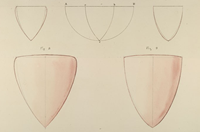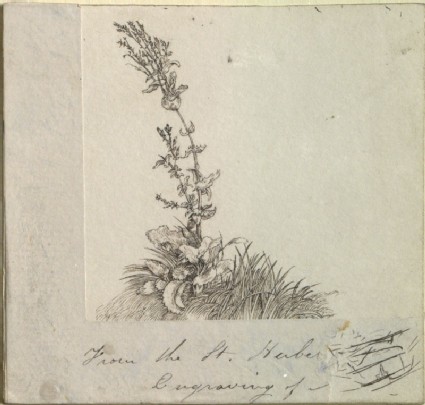Ruskin's Rudimentary series, 5th ed. (1873)
Items marked 'M' are drawings "by my own Hand" (by Ruskin), P are photographs, E engravings and A by Ruskin's Assistant, Arthur Burgess.

Ruskin's Catalogues: 1 object
Show search help- Reference URL
Actions
Copy...
Drawing of a Cluster of Leaves from Dürer's "Saint Eustace" George Allen
-
Ruskin text
241.With Mr. Burgess’ exquisite execution in the preceding example of cross-hatched pen-work I place a perfect example of linear pen-work, the lower subject in this frame, copied by Mr. Allen from Albert Dürer while I was teaching him drawing with a view to his becoming an engraver. The subject above is a pencil-study from Nature of Rouen Cathedral by my pupil M.r. Butterworth. Both these men were originally carpenters and came to me to the Working Men’s College to learn drawing. Both of them had been first rate workmen; M.r. Butterworth, I think, in simple carpentry, Mr. Allen a joiner. By examining these two drawings together, the student will, I hope, learn to appreciate the delicacy of touch involved in fine carpentry; for it was simply the transference of the fine qualities of finger which had been acquired by handling the carpenter’s tools to the pen and pencil that I obtained results, almost at once, of this extreme precision; in each case, of course, innate disposition for art having existed. I do not think the best student in these schools will easily rival the execution of the iron-worked spire in the upper drawing, still less of the grass in the lower one. I had no doubt of Mr. Butterworth far surpassing me, R. eventually, in architectural drawing, but his career was briefly brought to a close by an illness caused by bathing in a Welsh lake when he was heated, from which he never recovered so as to be able to work with his full energy again. Mr. Allen advanced steadily in skill, engraved for me several wonderful plates in Modern Painters, and is now the exclusive engraver of my drawings in the Laws of Fiesole and Deucalion. His plate of my drawing No. cannot, I think be rivalled either in line or mezzotint, either for skill or fidelity to his original; and the only complaint I have now to make of him is that he sometimes makes me ashamed of my own work.
-
Details
- Artist/maker
-
after Albrecht Dürer (1471 - 1528) (engraver)
- Object type
- drawing
- Material and technique
- pen and ink on card
- Dimensions
- 88 x 92 mm
- Inscription
- Recto, on the mount, bottom, in ink, partially torn off: From the St. Huber[t] | Engraving of
Verso:
lower right, in graphite (recent): Allen Ref 148
top left, and again centre, partial impressions of the Ruskin School's stamp
- Provenance
-
Presumably presented by John Ruskin to the Ruskin Drawing School (University of Oxford); first recorded in the Ruskin Drawing School in 1878; transferred from the Ruskin Drawing School to the Ashmolean Museum c.1949
- No. of items
- 1
- Accession no.
- WA.RS.REF.148
-
Subject terms allocated by curators:
Subjects
-
References in which this object is cited include:
References
Ruskin, John, ‘Rudimentary Series 1878’, 1878, Oxford, Oxford University Archives, cat. Rudimentary no. 241
Ruskin, John, ‘The Ruskin Art Collection at Oxford: Catalogues, Notes and Instructions’, Edward T. Cook and Alexander Wedderburn, eds, The Works of John Ruskin: Library Edition, 39 (London: George Allen, 1903-1912), 21, cat. Reference no. 148
Location
-
- Western Art Print Room
Ruskin's Catalogues
-
Ruskin's revision to the Rudimentary series (1878)
241.With Mr. Burgess’ exquisite execution in the preceding example of cross-hatched pen-work I place a perfect example of linear pen-work, the lower subject in this frame, copied by Mr. Allen from Albert Dürer while I was teaching him drawing with a view to his becoming an engraver. The subject above is a pencil-study from Nature of Rouen Cathedral by my pupil M.r. Butterworth. Both these men were originally carpenters and came to me to the Working Men’s College to learn drawing. Both of them had been first rate workmen; M.r. Butterworth, I think, in simple carpentry, Mr. Allen a joiner. By examining these two drawings together, the student will, I hope, learn to appreciate the delicacy of touch involved in fine carpentry; for it was simply the transference of the fine qualities of finger which had been acquired by handling the carpenter’s tools to the pen and pencil that I obtained results, almost at once, of this extreme precision; in each case, of course, innate disposition for art having existed. I do not think the best student in these schools will easily rival the execution of the iron-worked spire in the upper drawing, still less of the grass in the lower one. I had no doubt of Mr. Butterworth far surpassing me, R. eventually, in architectural drawing, but his career was briefly brought to a close by an illness caused by bathing in a Welsh lake when he was heated, from which he never recovered so as to be able to work with his full energy again. Mr. Allen advanced steadily in skill, engraved for me several wonderful plates in Modern Painters, and is now the exclusive engraver of my drawings in the Laws of Fiesole and Deucalion. His plate of my drawing No. cannot, I think be rivalled either in line or mezzotint, either for skill or fidelity to his original; and the only complaint I have now to make of him is that he sometimes makes me ashamed of my own work.






